Calathea, or the prayer plant, is one of the most beautiful houseplants you can grow. In some parts of Australia, they will grow outdoors even in winter, but even then, I’d find it hard to keep them outside.
In this article, I’m going to share some of my own tips, as well as a few from my partner whose calathea collection has (by her own admission) got out of control.
We both adore these beautiful plants, and wouldn’t live without them, but it took us a while to find the right space for them. We’ll talk about the best light conditions for calathea, and the best fertilisers for calathea too*.
(*But you might need to excuse some gushing as we go, as these are truly one of my favourite plants)
More...
What is a Calathea?

Calathea, also called the prayer plant, is a rhizomatous plant with generous foliage and intense architectural flowers. Calathea is in the Arrowroot, or Marantaceae, family.
The name arrowroot is a rough translation of their title in the Arawak language of the Lokono people, still living in South America and the Caribbean today. Aru-Aru, the native name for these plants means “meal of meals” referring to the calathea root’s ability to fill even the emptiest stomach.
While it’s unlikely you’ll eat your calathea roots, it’s a good depiction of how they grow: they store energy in thick taproots, which enable them to cope with erratic weather and incredibly heavy rain.
Calathea can even survive long hot droughts, but they will show their suffering. Their roots need constant moisture to swell and, if they deplete those moisture reserves, they are very susceptible to root rot.
Why Do Calatheas Move?
Calathea come as small as 10cm and as tall as 2m, but they all have a unique one thing in common – they react physically to light. As the sun goes down in the evening calathea leaves curl up, and twitch around each other until your plant has wrapped up completely for the night.
Calathea leaves move thanks to a water-filled joint at the base of each leaf. During the day the sun heats the joint and water expands. The pressure on the calathea leaf causes it to unfold.
As the temperature cools in the evening, and the sunlight stops warming the joint the leaf contracts and folds away. This movement is called nyctinasty but it is better known as ‘praying’, giving healthy calatheas the appearance of praying hands, clasped together.
While there is no conclusive evidence over why calathea plants have developed their unique ability to fold away at night, it is most likely to prevent water loss.
As any calathea parent knows, a well-watered calathea drops water from the tips of its leaves in the late afternoon and in the morning. By curling up, that water is directed back down to the roots.
9 Best Calathea Varieties to Grow in Australia
1. Round Leaf Calathea (Calathea orbifolia)C. orbifolia is one of the best-known prayer-plants, with white streaks across the leaves that look painted on. Their huge round leaves have rippled edges, and while they don’t close as dramatically as some other varieties, their mature leaves can wrap up like tacos in the evening. The paler leaves of C. orbifolia help them withstand direct sun more than other varieties, but they prefer being slightly shaded, or at least slightly away from the window to prevent sunburn. C. orbifolia also prefers slightly longer between watering than other calatheas, preferring the top inch of soil to be completely dry. |  |
2. Zebra Plant (Calathea zebrina)C. zebrina like regular watering, and don’t ever like to dry out completely. Their striped leaves are framed with bright green edges that crisp easily if they get too dry. The intense breeding of calatheas gives us incredible variety, but also leads to some extreme variation in care too. C. zebrina also forms larger clumps than other calatheas, so should be re-potted more regularly. | 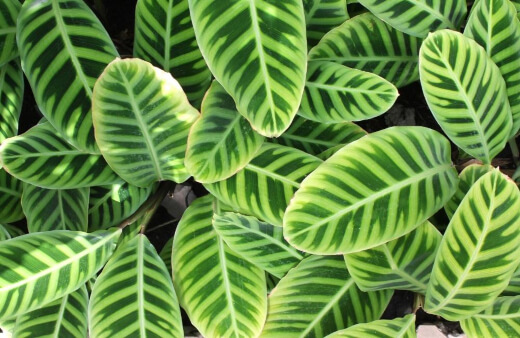 |
3. Peacock Plant (Goeppertia makoyana)Ok, so the peacock plant is technically not a calathea, but Goeppertia and Calathea are both arrowroots in the Marantaceae family that require near-identical care, and most garden centres sell G. Makoyana as ‘Calathea makoyana’ so you’d be forgiven for any confusion. Their stems grow slightly differently, but they both close up in the evenings, and just like calathea, these beautiful peacock plants need to be kept watered, and the surface of the soil should never be allowed to dry out completely. |  |
4. Pinstripe Plant (Calathea ornata)C. ornata, better known as the pinstripe plant, is probably best described as handsome. Its burgundy underside to each leaf is revealed every evening, as it’s one of the most dramatic evening movers, closing its leaves almost completely when it’s in the perfect light conditions. The strips give the leaves structure as well as a delicate beauty that adds to the pinstripe plant’s charm. In terms of care, the pinstripe plant is the quintessential calathea, needing dappled light in a bright space, good aeration, but high humidity, and watering 1-2 times per week to keep the soil from drying out completely. | 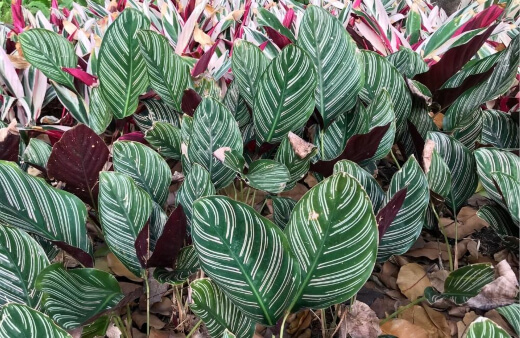 |
5. Rose Painted Calathea (Calathea ‘Roseopicta’)‘Roseopicta’ is often mistaken for the Peacock plant, but the significant difference is that as well as variegations in individual leaves, new leaves and mature leaves are slightly different colours, with paler centres in new leaves turning redder as they grow. They don’t like standing water on their leaves though, so while misting is advised, try to mist in the afternoons when there is a better chance of the water evaporating. Standing water on Calathea ‘Roseopicta’ can lead to brown spots that won’t recover. | 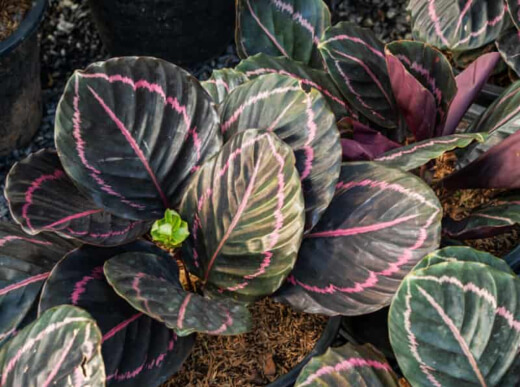 Source: plantly.io |
6. Furry Feather Calathea (Calathea rufibarba)Native to Bahia in Brazil, this rippled calathea is a really exciting plant. They twitch rather than close in the evenings, and love regular misting. In fact, provided they’re misted they can dry out around the base slightly, which is unusual for calatheas. Also known as the ‘furry feather calathea’, C. rufibarba has another unique trait, its fuzzy leaves. The dark red underside of each leaf on this calathea is covered in tiny hairs giving it an almost velvety texture that helps it retain moisture that would otherwise be lost through transpiration. |  Source: thecitywild.com |
7. Calathea ‘Vittata’The first time I saw a Calathea ‘Vittata’ I thought it was fake. Their leaves are so uniformly asymmetrical that they look handmade rather than a product of nature. The bright green leaves are swirled with white streaks that look like they’ve been carefully painted on. The leaves tend to droop if they’re overwatered too, so you get advance notice to stop watering for a while before it is too late. | 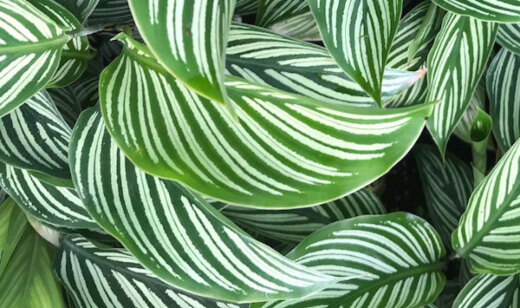 Source: ocera.org |
8. Calathea ‘Beauty Star’Calathea ‘Beauty Star’ is another variety that has many visual similarities with the peacock plant. Aside from its pointed leaf tip, the markings are almost identical. One significant difference is how quickly it can spread. These plants are incredibly well adapted to duplication and can be divided much more regularly than other calatheas. | 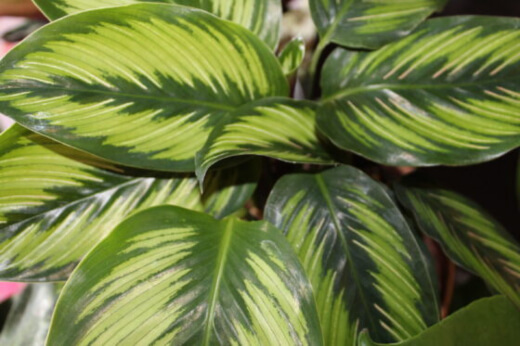 Source: suburbansucculents.com |
9. Calathea Medallion (Calathea veitchiana)Calathea Medallions are really substantial plants with upright round leaves and blood-red undersides that reach up to the moon at night. The top sides of Calathea Medallion can be quite varied, with perfect specimens having yellow markings that fall into a red centre, but most having paler white markings that look almost washed out. | 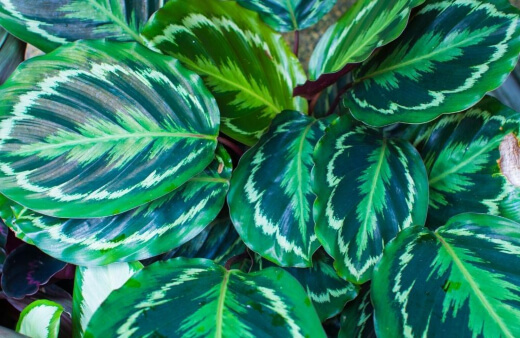 |
1. Round Leaf Calathea (Calathea orbifolia)

C. orbifolia is one of the best-known prayer-plants, with white streaks across the leaves that look painted on. Their huge round leaves have rippled edges, and while they don’t close as dramatically as some other varieties, their mature leaves can wrap up like tacos in the evening.


Get Your Free Guide:
Master Growing Australian Natives eBook
A Must Have Complete Guide for Every Australian Garden
Get Your Free Guide:
Master Growing Australian Natives eBook
A Must Have Complete Guide for Every Australian Garden
The paler leaves of C. orbifolia help them withstand direct sun more than other varieties, but they prefer being slightly shaded, or at least slightly away from the window to prevent sunburn.
C. orbifolia also prefers slightly longer between watering than other calatheas, preferring the top inch of soil to be completely dry.
2. Zebra Plant (Calathea zebrina)

C. zebrina like regular watering, and don’t ever like to dry out completely. Their striped leaves are framed with bright green edges that crisp easily if they get too dry.
The intense breeding of calatheas gives us incredible variety, but also leads to some extreme variation in care too.
C. zebrina also forms larger clumps than other calatheas, so should be re-potted more regularly.
3. Peacock Plant (Goeppertia makoyana)

Ok, so the peacock plant is technically not a calathea, but Goeppertia and Calathea are both arrowroots in the Marantaceae family that require near-identical care, and most garden centres sell G. Makoyana as ‘Calathea makoyana’ so you’d be forgiven for any confusion.
Their stems grow slightly differently, but they both close up in the evenings, and just like calathea, these beautiful peacock plants need to be kept watered, and the surface of the soil should never be allowed to dry out completely.
4. Pinstripe Plant (Calathea ornata)

C. ornata, better known as the pinstripe plant, is probably best described as handsome. Its burgundy underside to each leaf is revealed every evening, as it’s one of the most dramatic evening movers, closing its leaves almost completely when it’s in the perfect light conditions.
The strips give the leaves structure as well as a delicate beauty that adds to the pinstripe plant’s charm.
In terms of care, the pinstripe plant is the quintessential calathea, needing dappled light in a bright space, good aeration, but high humidity, and watering 1-2 times per week to keep the soil from drying out completely.
5. Rose Painted Calathea (Calathea ‘Roseopicta’)

Source: plantly.io
‘Roseopicta’ is often mistaken for the Peacock plant, but the significant difference is that as well as variegations in individual leaves, new leaves and mature leaves are slightly different colours, with paler centres in new leaves turning redder as they grow.
They don’t like standing water on their leaves though, so while misting is advised, try to mist in the afternoons when there is a better chance of the water evaporating.
Standing water on Calathea ‘Roseopicta’ can lead to brown spots that won’t recover.
6. Furry Feather Calathea (Calathea rufibarba)

Source: thecitywild.com
Native to Bahia in Brazil, this rippled calathea is a really exciting plant. They twitch rather than close in the evenings, and love regular misting.
In fact, provided they’re misted they can dry out around the base slightly, which is unusual for calatheas. Also known as the ‘furry feather calathea’, C. rufibarba has another unique trait, its fuzzy leaves.
The dark red underside of each leaf on this calathea is covered in tiny hairs giving it an almost velvety texture that helps it retain moisture that would otherwise be lost through transpiration.
7. Calathea ‘Vittata’

Source: ocera.org
The first time I saw a Calathea ‘Vittata’ I thought it was fake. Their leaves are so uniformly asymmetrical that they look handmade rather than a product of nature.
The bright green leaves are swirled with white streaks that look like they’ve been carefully painted on.
The leaves tend to droop if they’re overwatered too, so you get advance notice to stop watering for a while before it is too late.
8. Calathea ‘Beauty Star’

Source: suburbansucculents.com
Calathea ‘Beauty Star’ is another variety that has many visual similarities with the peacock plant. Aside from its pointed leaf tip, the markings are almost identical. One significant difference is how quickly it can spread.
These plants are incredibly well adapted to duplication and can be divided much more regularly than other calatheas.
9. Calathea Medallion (Calathea veitchiana)

Calathea Medallions are really substantial plants with upright round leaves and blood-red undersides that reach up to the moon at night.
The top sides of Calathea Medallion can be quite varied, with perfect specimens having yellow markings that fall into a red centre, but most having paler white markings that look almost washed out.
How to Grow Calathea
Planting Calathea Indoors
Calathea should be grown in indirect light but in bright rooms. They do not like direct sun, or full shade, despite what plant labels might suggest.
Calathea is a tropical forest floor plant that thrives in dappled light and humid conditions. While they don’t enjoy sitting in water they like regular water and will, like any root vegetable, grow towards water.
So when watering calathea indoors it’s a good idea to keep it standing on a tray of pebbles with water in the base. This allows drainage from the pot above while keeping the bottom of the compost moist so the roots grow deeper and stronger.
Calathea leaves will show you very quickly if they are over or under watered, especially for indoor plants.
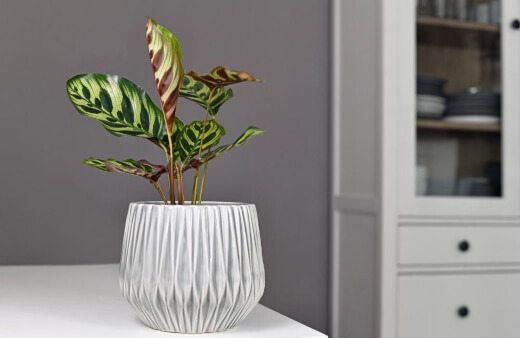
Planting Calathea Outdoors
Calatheas are hardy through most of Australia but don’t like changeable weather, so are best grown indoors, or as a patio container plant, ideally, bringing the container indoors for winter to protect it from frost.
Other than winter protection outdoor calathea care is a case of finding a warm spot with dappled shade on a patio, where your calathea is protected from wind, and kept out of direct midday sun.
Watering via drip irrigation can be a useful tool for calatheas, particularly in summer.
Calathea Propagation

How to Propagate Calathea from Division
While you can’t grow calathea from cuttings, mature plants will happily be divided in spring or summer provided there are clear clumps in your pot.
Calathea can be quite tangled at the root, where fibrous roots extend beyond their main tap root, and new roots extend from the main root (eventually separating into their own plant).
Any part of the plant above the soil that is clearly growing from a separate group of stems can simply be pulled off the main roots and reported.
Plant them into fresh soil, and keep them moist but not over-watered for a few weeks and new roots should start growing pretty quickly.
Propagating Calathea from Seed
While you’re unlikely to find calathea seeds in your local garden centre, it’s unlikely that even a pollinated indoor calathea will produce viable seeds as they need very exact conditions to ripen.
But, it’s not actually that hard to propagate from seed, and once germinated they can grow reasonably quickly.
You’ll need to find a reputable online seed shop that specialises in house plants to make sure you’re buying viable seeds, but once you have them, here’s what you need to do to grow calathea from seed:
- Fill a seed tray with a good quality seed compost (not too rich, and ideally sieved), mixed with horticultural sand or vermiculite for drainage (50:50).
- Moisten the soil, then thinly sow the seeds and cover with 5mm of compost.
- Place the tray in a covered heated propagator, or on a warm windowsill where they are kept at about 18-21°C.
- They should germinate within around 14 days (usually at around a 25% success rate).
- When they’re around 5cm tall, gently prick individual plants out and put them in their own pot with 50:50 vermiculite to houseplant compost.
Caring for Calathea
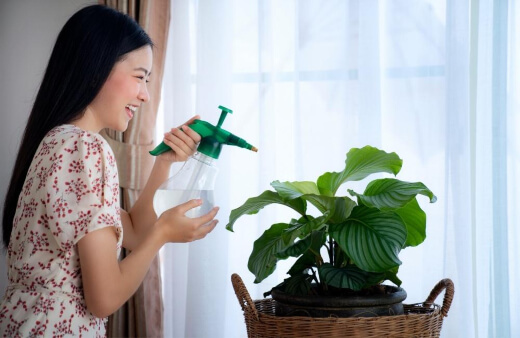
Mulching Calathea
Calathea grown indoors don’t need any mulch, but it's good practice to replace the soil every two years anyway. This reinvigorates the roots, which will be gently disturbed by the process.
The new compost helps give the roots a boost in the same way as mulch would, but without the risk of stem rot at the base.
(Make your own compost using the best compost bins available today.)
What Fertiliser to Use
The best fertiliser for calatheas is a well-balanced houseplant feed that doesn’t focus on any one nutrient. A 10-10-10 NPK houseplant food is ideal for Calathea. Miracle-Gro Push & Feed cones aren’t perfect, but they’re one of the best slow-release fertilisers, and they work for veggies too, so are handy to have in the cupboard.
Watering Calathea
Calatheas are generally quite easy to care for once you’ve found the right spot for them, but watering can be tricky so it’s important to get to know your soil.
While most houseplants come with the guidance, “don’t water unless the top 5cm of soil is dry '', Calathea is more like “don’t water unless the top 5 cm of soil is drier than normal”.
Drier than normal depends on the soil, and what your calathea is used to because they adapt well to their containers.As a general guide for calathea water, you should water once a week in summer.
Regular Misting
Calathea should be regularly misted throughout the year. As we described earlier, they are moisture-loving plants that are used to well-drained soil, but plenty of humidity thanks to their natural environment.
Indoor spaces, with air conditioning, radiators and kitchen appliances can dry the air out incredibly quickly, so make sure to mist your calathea at least once a week.
Repotting Calathea
When calatheas are starting to outgrow their container they should be re-potted. They don’t like being restricted and are happy in slightly moister soil, so if you leave them to outgrow their pot they can really start to suffer.
By dividing calathea into several pots you can keep your plants in the same pot for longer, but if you just want a dramatic clump, then pot on, into a container no more than 2” bigger than its current home.
If you give too much new space, it can lead to standing water in the soil.
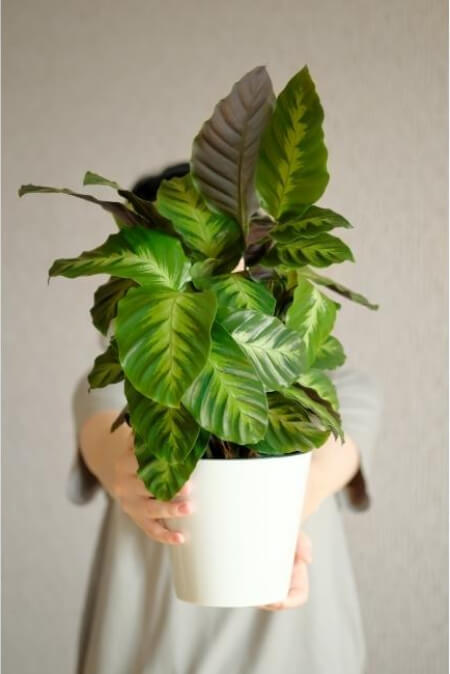
Winter Care
While many houseplants go dormant in winter, calathea continue growing, so should be kept watered during the winter months. After autumn when the leaves stop growing and looking a little tired, cut back on watering, maybe down to once a month rather than once a week, so you don’t overwater these delicate plants.
However you’re watering though, remember that calathea like humidity, and so in winter when your radiators are on, mist the plants more often to keep the foliage healthy. If the leaf edges turn brown and crispy they won’t recover.
Common Calathea Pests and Diseases
Treating Spider Mites
Spider mites are tiny red arachnids that are often thought to be separate insects entirely, but they’re very closely related to spiders, and spin white webs on the underside of calathea leaves.
They are often mistaken for mealybugs too, as they wrap their eggs in white silk to protect them, which looks like small clusters of mealy bugs.
The best treatment for spider mites is a neem oil spray. Neem oil is easy to find online, and a great organic pesticide, which turns inert once dry, so won’t harm other creatures.
Mealybugs
Mealybugs on calathea is a really common problem because these plants are shipped from growers all over the world, with one flat-pack furniture store that I won’t name selling houseplants that are constantly infested with mealybug in the soil.
Once calathea get mealybug on them, it can be an uphill battle, but they’re easy to spot thanks to their powdery white coating. To get rid of mealybug, you can either dab them directly with rubbing alcohol, which kills them instantly or hoover them up.
Calatheas are surprisingly receptive to being gently hoovered, and it’s a brilliant way to quickly get rid of a big infestation fast.
Thrips and Whitefly
While thrips and whitefly are less common on calathea than spider mites and mealybug, they can be hard to get rid of when they happen. Because they move around more easily and can hide on soil and away from plants.
Ladybugs eat thrips and whiteflies, but releasing a pack of hungry ladybugs into your house might not be the best idea. Neem oil is effective against both though, so if you spot thrips of whitefly, act fast before they spread.
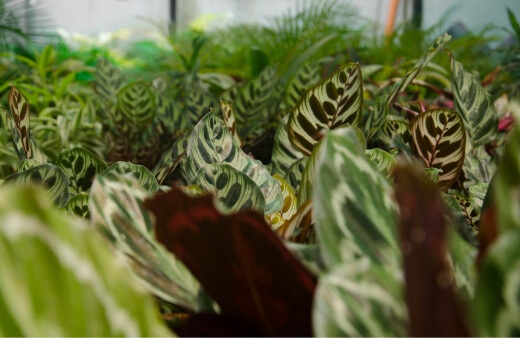
Calathea are well adapted to humid environments so aren’t very susceptible to damp or fungal problems, but if you notice yellowing leaves, it’s likely caused by root rot, which we’ll cover below.
The majority of other problems in calathea are caused by overexposure to sunlight, which is easily treated by pruning affected leaves and moving to a more shaded location.
Treating Calathea Root Rot
Calathea root rot can happen with old compost, or from overwatering, but if your calathea roots are staying moist for weeks without new water, then there’s almost definitely a problem.
It can be caused by poor lighting, where the calathea isn’t photosynthesising enough, or even thrips laying eggs, and the grubs damaging calathea roots.
Whatever the cause, there is only one solution. To treat root rot, you need to tip your plant out of the pot, onto newspaper, and check for any blackened, brown, or dead roots.
Calathea roots should be creamy white, so any deviation from that is a bad sign.
- Once you’ve identified root rot, wash off all the soil
- Cut off any rotten plant material that’s black, slimy, green, or brown.
- Disinfect the clean roots with a mix of one part 6% hydrogen peroxide, to four parts water (1:4), then rinse the solution well
- Leave the roots to air dry for an hour or so
- Sterilise the pot by cleaning with bleach
- Re-pot into new houseplant compost, with added vermiculite to aid drainage
- Prune 90% of the leaves, and water once a week until new growth appears. (Get reliable pruning shears here)
- Don’t use any fertiliser. This encourages new root growth to search for nutrients in the soil.
Frequently Asked Questions About Calathea
Is calathea easy to grow?
Calatheas are easy to grow compared to most houseplants, but they do need you to pay them more attention than most when you first get one.
Calatheas are very fussy about their location and don’t like being moved, so for the first month, it’s worth moving them once a week and seeing if there are any negative reactions to their space. If they look healthy after a week, leave them be.
Why has my calathea stopped curling?
Calathea that stop curling are likely getting too much artificial light in the evening. They react to heat and light by swelling and constricting joints at the base of their leaves.
Plants can get confused under artificial lighting, so consider moving your calathea to a room you use less often in the evenings.
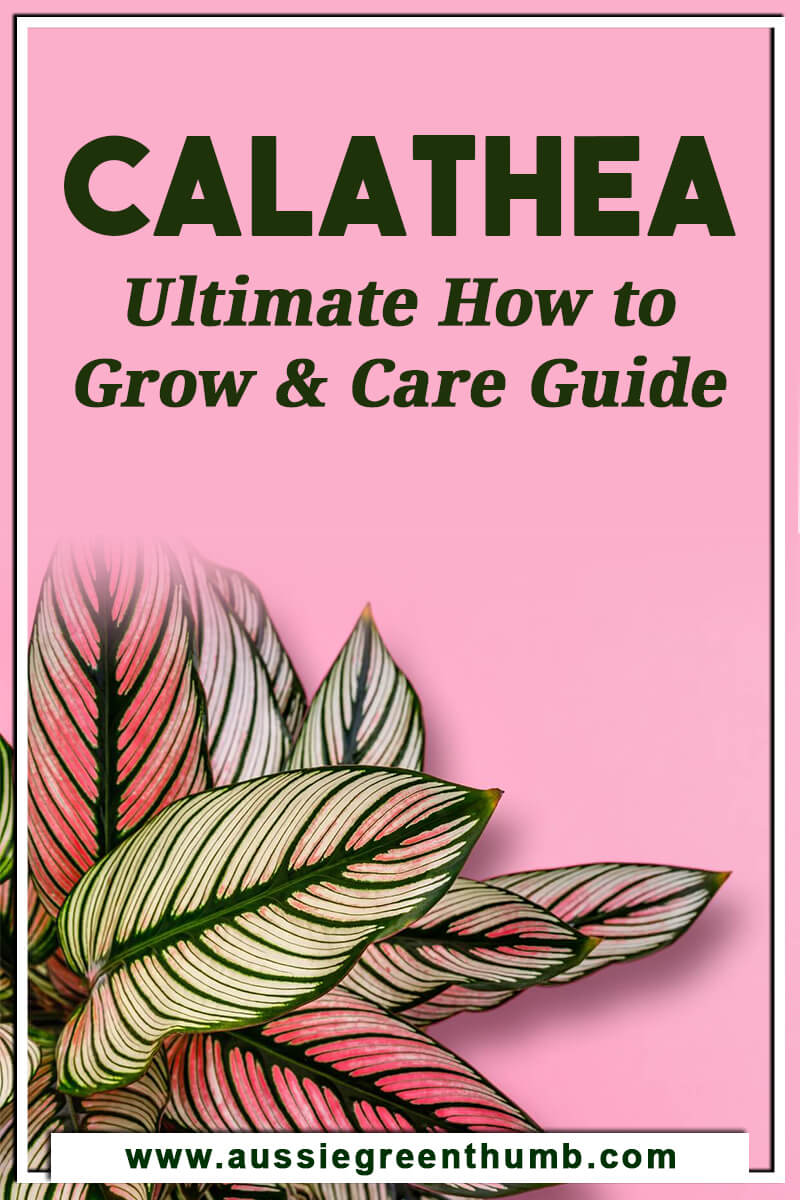
Immerse Your Garden in the Captivating Allure of Calathea
It sounds silly, but calatheas became like part of the family. They remind you what time of day it is by moving as the sun goes down, and they keep you on your toes as they twitch throughout the evening. When you find the right place for calatheas, they’ll tell you about their dramatic evening movements.
Now you know how to grow calatheas, and have more of an idea about the different types of calathea you can grow in Australia, I think it’s fair to say you’ve got no excuse. If you don’t already have a prayer plant, go out and buy one.
Published on March 3, 2022 by Maisie Blevins
Last Updated on September 10, 2025




